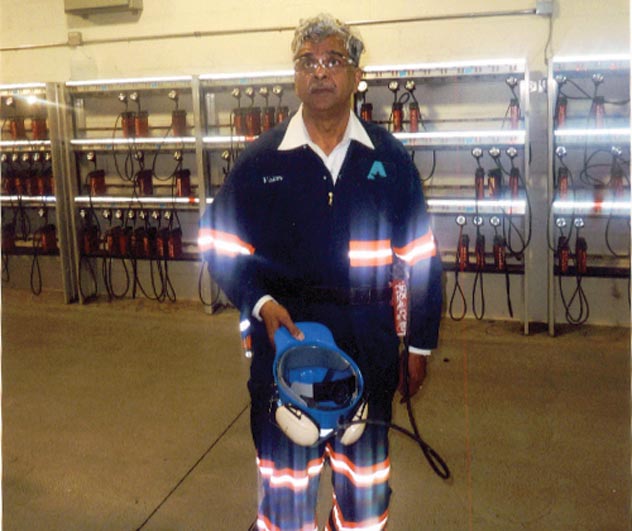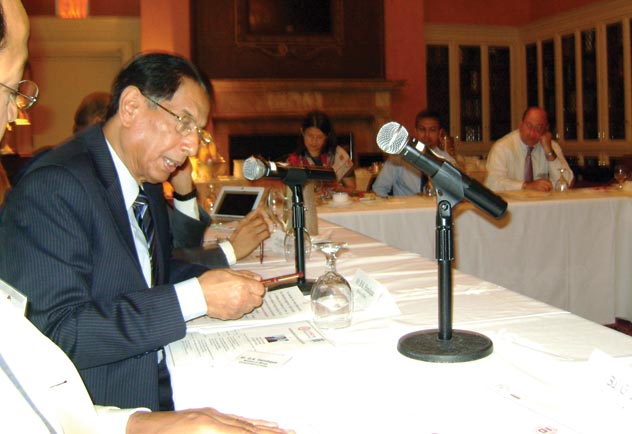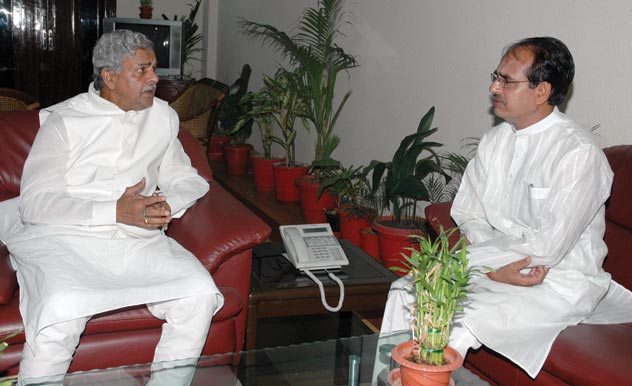SUBCONTINENT
Coal Block Auction: New Mining Act
Following in the footsteps of the oil and gas sector, India’s new mining law will allow competitive auction of coal blocks, and there are plans for a mining regulator, special courts to redress disputes and involvement of affected local populations, writes Siddharth Srivastava.

(Above): Indian Minister of State of Coal, Statistics and Program Implementation Sriprakash Jaiswal at underground coal mines of Alpha Natural Coal Resources, U.S. during his visit to the U.S. in May. Jaiswal says there is a strong case of opening the coal sector to private firms because it is not possible for state firms alone to meet the demand-supply gap. [Photo: PRESS INFORMATION BUREAU]
In a long awaited move, India’s Parliament has finally amended the Mines and Minerals Development and Regulation Act — MMDRA — of 1957 that will enable competitive auction of coal blocks.
The new bidding system replaces the current process of allocating coal blocks via an inter-ministerial screening committee seen as flawed in terms of transparency and long-term investor interest.
The new model approximates the reasonably sound paradigm of India’s oil and gas sector that has attracted domestic and foreign investors and led to exploration successes.
It is estimated that there are nearly 80 unexplored coal blocks to be given away. Companies like BHP Billiton, Rio Tinto, Vale, Monnet Ispat, Gujarat NRE, the Tata Group and the Jindals are expected to benefit.
New Delhi is also working on provisions for a mining regulator, special courts to redress disputes and involvement of affected local populations. This new set of amendments will be brought through the MMDRA Bill 2010.
According to federal Coal Minister Sriprakash Jaiswal, “It is not possible for the state firms alone to meet the demand-supply gap (in coal)... there is a strong case for opening the sector.”
Indian firms have been forced to seek overseas coal sources as the country’s coal demand is expected to touch 730 metric tons by 2011-12, while domestic supply is estimated at 520 metric tons, leaving a shortfall of over 200 metric tons.
Coal consumption in India has soared in the construction sector (steel, cement) and by power firms.
Coal Ministry Moves
Following the new statute, the federal Coal Ministry has initiated steps to appoint consultants to create a databank of coal blocks to be put on auction to private developers. The data will help evaluate the price and prospects of the coal blocks on offer.
According to federal Mines Minister B.K. Handique the earlier allocation system “was vulnerable to criticism on ground of lack of transparency and objectivity. The new system of competitive bidding is expected to bring in transparency.”
So far New Delhi has allotted over 210 blocks to firms (private and state owned), out of which a mere 24 blocks have begun coal production. The Coal Ministry has thus stopped allocating coal mines and fresh allocation will only begin when the competitive bidding process is in place.
Jaiswal said, “We need to open the sector for bringing market discipline. This needs political consciousness. Pending the same, (the) government is encouraging group captive-mining to augment production.”

(Above): Minister for Mines and Development of North Eastern Region B.K. Handique addressing the U.S.- India Business Council, organized by the Manhattan India Investment Round Table in New York in July. Handique says a new system of competitive bidding is expected to bring in transparency while the earlier allocation system “was vulnerable to criticism on ground of lack of transparency and objectivity.” [Photo: PRESS INFORMATION BUREAU]
Private Developers Upbeat
Private developers have been seeking open auctions of coal blocks that were instead being reserved for state-run monopoly Coal India Limited.
Welcoming the latest amendments, Tata Steel, said in a statement: “Single-window clearances and environmental approvals, free availability of data, friendly legal rules, fair regulatory body, better infrastructure are mandatory to meet domestic coal targets.”
As things stood, private players were allowed captive use of coal blocks that are “allocated” by the government that led to large scope for capitation and entry of non serious players.
This also resulted in firms sitting on coal blocks without any intention of developing them and in the hope of selling at a premium should the government allow open merchant sales of coal.
Major coal consumers in the country include state owned NTPC, private entities Reliance Power, Jindal Steel & Power, Adani Power, Torrent Power, Essar, SAIL, Lanco Infratech, among others.
Transparency in Coal
Observers say that it is important for India to bring about a clear policy in coal.
A shoddy paradigm has resulted in proliferation of illegal mining that has grown into a multi-million scam undertaken in the cover of darkness and clandestine night bulbs to escape detection.
The incidence of theft and pilferage from existing stocks, inventories or while in railway-transit have risen.
Official data suggests that 182,000 cases of illegal mining have occurred across 17 states in the last five years.
In its draft red herring prospectus for its upcoming Rs 120 billion IPO in October, CIL, that produces over 80 percent of India’s coal output, has warned: “There can be no assurance that illegal mining activities or pilferage of coal from our mines or stockpiles will not increase in the future.”
Over 90 percent of CIL output is from coalfields located in illegal mining-infested states of Chhattisgarh, West Bengal, Orissa, Madhya Pradesh, Jharkhand and Maharashtra.

(Above): Madhya Pradesh Chief Minister Shivraj Singh Chauhan meeting the Minister of State (Independent Charge) of Coal, Statistics and Program Implementation Sriprakash Jaiswal to discuss the issue of coal mining and coal supply in Madhya Pradesh, in New Delhi May 4. Jaiswal says he believes in the need to open the coal sector for bringing market discipline. [Photo: PRESS INFORMATION BUREAU]
Involving Tribals
In MMDRA 2010, New Delhi has proposed to make it mandatory for mining firms to allot 26 percent of a project’s equity to local population affected by a mining project.
Though the move is opposed by industry, Handique has said, “Full justice would be done to the tribal population and issues relating to ecological balance will be considered.”
India’s acute Maoist and Naxal insurgency and rapacious mining in forested and protected areas are closely related, most analysts agree.
Tribals constitute over 8 percent of the country’s population but account for 40 percent of 50-60 million displaced since India’s independence (in 1947) due to land diversion, particularly by state firms for mining.
According to brokerage CLSA Asia-Pacific Markets, Maoist activity threatens nearly $80 billion worth of natural-resource projects.
According to official estimates, state-run Central Coalfields Ltd lost 1.12 metric tons of coal production from April to June due to Maoist activities. This was almost the same as the 1.15 metric tons lost in 2009-10.
The heavily armed Naxals who took to violence to protect their natural resources and exploitation have ironically turned plunderers alongside illegal miners and demand protection money.
|